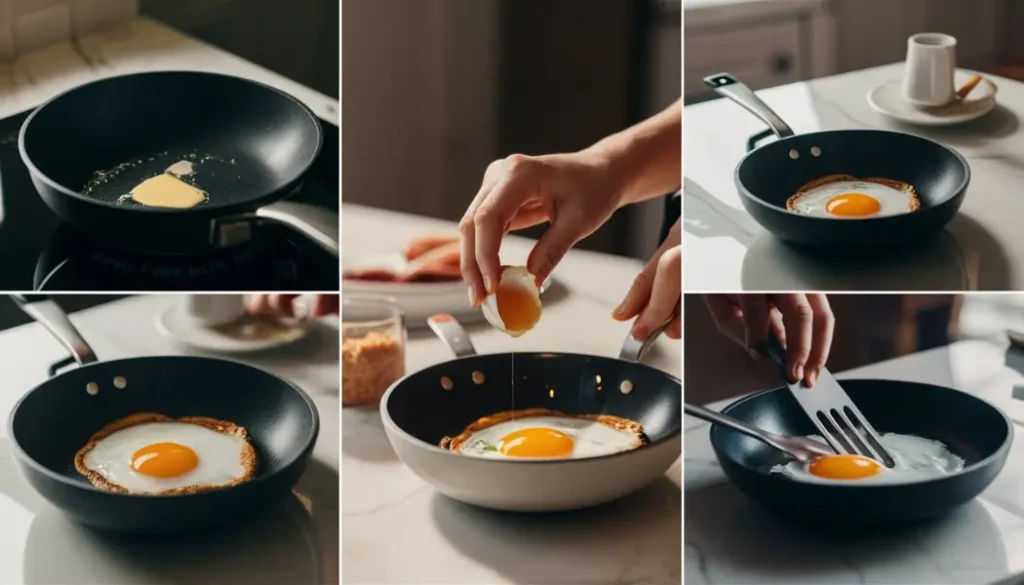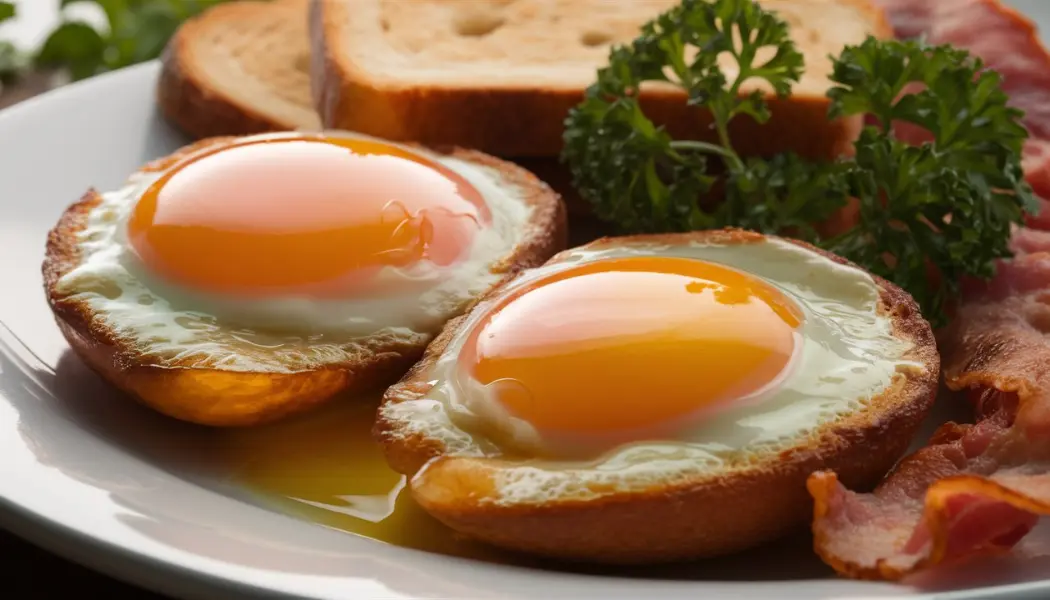Eggs are one of the most versatile and popular foods worldwide, and they can be cooked in many ways. From scrambled to poached, each method brings a unique flavor and texture. One of the most beloved ways to cook eggs is over medium, a perfect balance between runny and fully cooked.
In this article, we’ll explore how over medium eggs are cooked, what sets them apart from other egg styles, and provide a step-by-step guide for cooking them perfectly. Whether you’re new to cooking eggs or just looking to improve your technique, this guide will help you master the art of making over medium eggs.
What Are Over Medium Eggs?
Over medium eggs are a style of fried egg where the whites are fully set, and the yolk is partially cooked. The yolk should be thick but still a little runny in the center, giving you the best of both worlds—creamy yolk without being too runny, and firm whites.
Comparing Over Medium to Other Styles
Over medium eggs fall between over easy and over hard on the spectrum of fried eggs:
- Over easy: The egg is flipped, but the yolk remains runny. The whites are cooked just until set, and the yolk is still very soft.
- Over hard: The egg is flipped, and both the whites and yolk are fully cooked. The yolk is firm, with no runniness at all.
- Sunny side up: The egg is cooked without flipping. The whites are firm, but the yolk remains completely runny.
Why Choose Over Medium?
People love over medium eggs because they offer a perfect middle ground. The whites are fully cooked and firm, while the yolk is partially cooked but still soft enough to dip toast in. It’s a great option for those who enjoy a little bit of runny yolk but want to avoid the full liquid center of an over easy egg. It also provides a richer texture compared to over hard eggs, making it a popular choice for breakfast.
In short, over medium eggs provide the perfect balance for egg lovers who want a mix of soft and firm textures.
Step-by-Step Guide to Cooking Over Medium Eggs

Cooking over medium eggs requires a careful balance of timing and temperature. Follow these steps to ensure your eggs come out perfectly every time.
Step 1: Gather Your Equipment
Before you start cooking, you’ll need a few basic tools:
- A non-stick frying pan to prevent the eggs from sticking.
- A spatula to flip the eggs without breaking the yolk.
- Butter or oil for greasing the pan.
A non-stick pan is crucial for making over medium eggs, as it makes flipping the eggs much easier and reduces the chance of the yolk breaking.
Step 2: Preheat the Pan
Set your stove to medium-low heat and add a small amount of butter or oil to the pan. Let the pan preheat for about a minute, making sure the butter melts evenly without browning. If the pan is too hot, the eggs will cook too quickly and may burn or become rubbery.
Step 3: Crack the Egg into the Pan
Once the pan is preheated, crack the egg gently into the pan. If you’re nervous about breaking the yolk, you can crack the egg into a small bowl first and then gently slide it into the pan. Let the egg cook for about 2 to 3 minutes, or until the whites are set but the yolk is still runny on top.
Step 4: Flip the Egg
The key to over medium eggs is flipping them at just the right time. Once the whites have set (they should be opaque and firm), use your spatula to gently flip the egg. Be careful not to break the yolk during this step. If you’re unsure, you can tilt the pan slightly to help slide the egg onto the spatula.
Step 5: Cook the Other Side
After flipping, let the egg cook for another 1 to 2 minutes. This will cook the yolk enough to thicken it slightly, but it should still be soft in the center. Keep an eye on the egg, as leaving it too long will cause the yolk to firm up and lose the runny texture that makes over medium eggs so delicious.
Once the egg is done, gently transfer it to a plate. The whites should be fully set, and the yolk should have a soft, creamy consistency when cut open.
The Perfect Temperature and Timing
The secret to perfectly cooked over medium eggs lies in the temperature and timing. These two factors work together to ensure the whites are cooked through without burning, and the yolk is soft but not runny.
The Ideal Heat Setting
When cooking over medium eggs, the heat should be set to medium-low or medium. Cooking at a lower temperature gives you more control over the process and prevents the eggs from cooking too fast. If the pan is too hot, the whites may burn while the yolk remains undercooked. Starting with medium heat allows the eggs to cook evenly without rushing the process.
Timing: How Long to Cook Over Medium Eggs
Timing is crucial when making over medium eggs. Here’s a general breakdown:
- First side: Let the egg cook for 2 to 3 minutes on the first side. You’ll know it’s ready to flip when the whites are fully set, and the yolk is still bright yellow but runny on top.
- Second side: Once flipped, cook the egg for another 1 to 2 minutes. The goal is to cook the yolk just enough to make it thicker but still soft when you cut into it.
Preventing Overcooking
To prevent overcooking, keep a close eye on the egg after flipping. Over medium eggs can quickly turn into over hard if left on the heat for too long. The yolk should still have some movement when you gently shake the pan, indicating it’s cooked but not fully solid.
If you notice the whites are browning too much before the yolk is ready, lower the heat slightly. Adjusting the temperature can help control the cooking process and give you a perfectly cooked over medium egg.
In conclusion, cooking over medium eggs is all about using the right temperature and paying attention to the timing. By following these guidelines, you can achieve a soft, creamy yolk and fully set whites every time.
Tips for Getting Over Medium Eggs Just Right

Making perfect over medium eggs requires some practice, but a few key tips can help you get it right every time. These tips ensure you achieve the ideal balance between soft yolks and firm whites.
1. Use the Right Tools
Using a non-stick pan and a flexible spatula makes flipping eggs much easier. The non-stick surface prevents the eggs from sticking, and the spatula helps you flip the eggs without breaking the yolk. If you don’t have a non-stick pan, adding extra butter or oil can help reduce sticking.
2. Don’t Rush the Cooking Process
Cooking over medium eggs requires patience. Keep the heat on medium or medium-low to avoid cooking the eggs too quickly. High heat cooks the whites unevenly and makes the yolk firm up too much. By taking your time, you’ll have soft yolks and fully cooked whites.
3. Flip Carefully
Flipping the egg is the trickiest part. To avoid breaking the yolk, use the edge of your spatula to gently slide under the egg. You can also tilt the pan slightly to help the egg slide onto the spatula. When flipping, move smoothly and don’t rush the process. Practicing this technique makes a big difference.
4. Check the Yolk
After flipping the egg, keep an eye on the yolk’s texture. The goal is to keep it soft, not runny or hard. You can gently shake the pan to see how much the yolk moves. When it moves slightly but isn’t fully liquid, it’s ready. This timing ensures a perfect over medium egg.
5. Use Fresh Eggs
Fresh eggs hold their shape better and are easier to flip. The whites in older eggs tend to spread out more, making it harder to achieve that perfect round shape. Fresh eggs also have firmer yolks, which helps when you need to flip them without breaking.
By following these tips, you can consistently cook perfect over medium eggs with firm whites and soft, creamy yolks.
Common Mistakes and How to Fix Them

Cooking over medium eggs may seem simple, but a few common mistakes can make the process tricky. Here’s how to avoid them and fix any issues along the way.
1. Cooking on Too High Heat
Many people make the mistake of cooking eggs on heat that’s too high. High heat cooks the whites too fast, leading to browning or burning while the yolk stays too runny. The solution is to lower the heat to medium or medium-low. This gives you more control and ensures even cooking.
2. Breaking the Yolk When Flipping
Flipping the egg can be challenging, and breaking the yolk is a common issue. To avoid this, make sure the whites are fully set before flipping. Use a flexible spatula to gently lift the egg, tilting the pan if needed. Flipping too soon or too quickly leads to broken yolks. If you break the yolk, don’t worry—just continue cooking it as over hard.
3. Overcooking the Yolk
Sometimes, the yolk cooks too long and ends up more solid than intended. To prevent this, watch the timing carefully. After flipping, cook the egg for just 1 to 2 minutes. Checking the yolk’s movement by gently shaking the pan can help you know when it’s done. If the yolk barely moves, it’s time to take the egg off the heat.
4. Unevenly Cooked Whites
If the whites don’t cook evenly, it may be due to high heat or not spreading the egg properly. Make sure the pan is preheated at medium heat, and allow the egg to spread out naturally in the pan. If some areas of the whites are still runny after flipping, you can press the spatula down lightly to help them cook through.
5. Using the Wrong Pan
A non-stick pan is essential for cooking eggs, especially when you need to flip them. Using a sticky pan makes it much harder to achieve clean, smooth flips without breaking the yolk. Always use non-stick cookware or add extra butter or oil to prevent sticking.
By addressing these common mistakes, you’ll improve your over medium egg-making skills and avoid frustration in the kitchen.
FAQ
What’s the difference between over easy and over medium eggs?
The main difference lies in the yolk’s consistency. Over easy eggs have a fully runny yolk, while over medium eggs have a partially cooked yolk that is still soft but not completely runny. Over medium eggs offer a balance between the liquid center of over easy and the fully cooked yolk of over hard.
How do you know when to flip the egg?
You should flip the egg when the whites are fully set, but the yolk is still runny. Look for the whites to turn opaque and no longer appear jiggly. The yolk should remain uncooked at this stage. Waiting until the whites are completely cooked before flipping prevents breaking the yolk.
Can you cook over medium eggs in oil or butter?
Yes, you can cook over medium eggs in either oil or butter. Butter adds richness and flavor, while oil helps prevent sticking. Both work well, but make sure not to overheat the pan. Cooking in butter adds a slight golden color to the whites, while oil will keep them more neutral.
Why do my eggs keep breaking when I flip them?
Eggs may break during flipping if the yolk isn’t protected by fully set whites. Be patient and wait for the whites to set completely before flipping. A gentle flip with a flexible spatula also helps avoid breaking the yolk. If you flip too fast or aggressively, you’re more likely to break the egg.
How do I keep the yolk from becoming too hard?
To keep the yolk from becoming too hard, monitor the cooking time closely. After flipping the egg, cook for only 1 to 2 minutes. You want the yolk to remain soft, with a little movement when you shake the pan gently. Cooking beyond 2 minutes will result in a firmer yolk, which is more suited for over hard eggs.
Conclusion
Cooking over medium eggs is all about finding the right balance between runny and firm. The whites are fully cooked, and the yolk is slightly soft, offering a perfect combination of textures. By using medium heat, the right tools, and flipping carefully, you can master this cooking style. Whether you’re making them for breakfast or a quick snack, over medium eggs bring richness and flavor to any meal.
Remember to follow the tips and steps outlined here, from using a non-stick pan to timing your cooking just right. With practice, you’ll be able to make over medium eggs perfectly every time.
